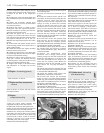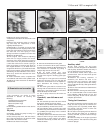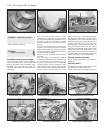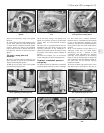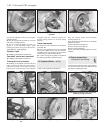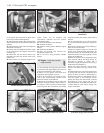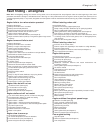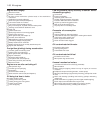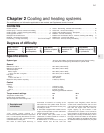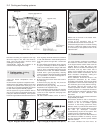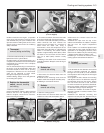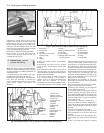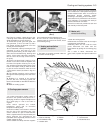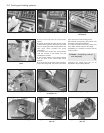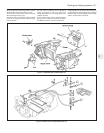
Engine idles roughly
ⅥⅥ Mixture too weak
ⅥⅥ Air leak in carburettor
ⅥⅥ Air leak at inlet manifold to cylinder head, or inlet manifold to
carburettor
ⅥⅥ Carburettor incorrectly adjusted
ⅥⅥ Other fuel system fault (see Chapter 3)
ⅥⅥ Low tension leads on coil loose
ⅥⅥ Low tension lead to distributor loose
ⅥⅥ Dirty, incorrectly set, or pitted contact breaker points
ⅥⅥ Tracking across inside of distributor cover
ⅥⅥ Faulty coil
ⅥⅥ Ignition leads loose
ⅥⅥ Spark plugs fouled or incorrectly gapped.
ⅥⅥ Ignition timing incorrect
ⅥⅥ Other ignition fault (see Chapter 4)
ⅥⅥ Incorrect valve clearances
ⅥⅥ Widely differing cylinder compressions
ⅥⅥ Low battery voltage (charging fault)
ⅥⅥ Battery leads loose on terminals
ⅥⅥ Battery earth strap loose on body attachment point
ⅥⅥ Engine earth lead loose
Pre-ignition (pinking) during acceleration
ⅥⅥ Incorrect grade of fuel being used
ⅥⅥ Ignition timing over-advanced
ⅥⅥ Other ignition fault (see Chapter 4)
ⅥⅥ Engine overheated
ⅥⅥ Excessive carbon build-up
ⅥⅥ Fuel system fault (see Chapter 3)
ⅥⅥ Valve timing incorrect (after rebuild)
ⅥⅥ Mixture too weak
Engine runs on after switching off
ⅥⅥ Idle speed too high
ⅥⅥ Incorrect type of spark plug
ⅥⅥ Overheating
ⅥⅥ Excessive carbon build-up
ⅥⅥ Other emission control fault (see Chapter 3)
Oil being lost due to leaks
ⅥⅥ Leaking oil filter gasket
ⅥⅥ Leaking rocker cover gasket
ⅥⅥ Leaking timing gear cover gasket
ⅥⅥ Leaking sump gasket
ⅥⅥ Loose sump plug
Low oil pressure (verify accuracy of sender before
dismantling engine!)
ⅥⅥ Oil level low
ⅥⅥ Engine overheating
ⅥⅥ Incorrect grade of oil in use
ⅥⅥ Oil filter clogged or bypass valve stuck
ⅥⅥ Pressure relief valve stuck or defective
ⅥⅥ Oil pick-up strainer clogged or loose
ⅥⅥ Main or big-end bearings worn
ⅥⅥ Oil pump worn or mountings loose
Excessive oil consumption
ⅥⅥ Overfilling
ⅥⅥ Leaking gaskets or drain plug washer
ⅥⅥ Valve stem oil seals worn, damaged or missing after rebuild
ⅥⅥ Valve stems and/or guides worn
ⅥⅥ Piston rings and/or bores worn
ⅥⅥ Piston oil return holes clogged
Oil contaminated with water
ⅥⅥ Excessive cold running
ⅥⅥ Leaking head gasket
ⅥⅥ Cracked block or head
Oil contaminated with fuel
ⅥⅥ Excessive use of choke
ⅥⅥ Worn piston rings and/or bores
Unusual mechanical noises
ⅥⅥ Unintentional mechanical contact (eg fan blade)
ⅥⅥ Worn drivebelt
ⅥⅥ Worn valvegear (tapping noises from top of engine) or incorrect
clearance
ⅥⅥ Peripheral component fault (generator, coolant pump)
ⅥⅥ Worn big-end bearings (regular heavy knocking, perhaps less under
load)
ⅥⅥ Worn main bearings (rumbling and knocking, perhaps worsening
under load)
ⅥⅥ Small-end bushes or gudgeon pins worn (light metallic tapping)
ⅥⅥ Piston slap (most noticeable when engine cold)
ⅥⅥ Worn timing chain and gears (rattling from front of engine)
ⅥⅥ Worn crankshaft (knocking, rumbling and vibration)
1•36 All engines



